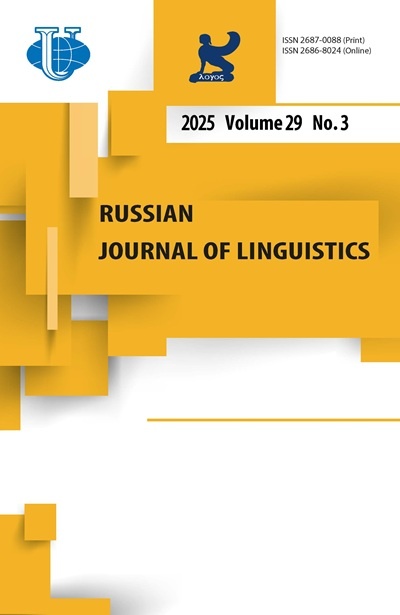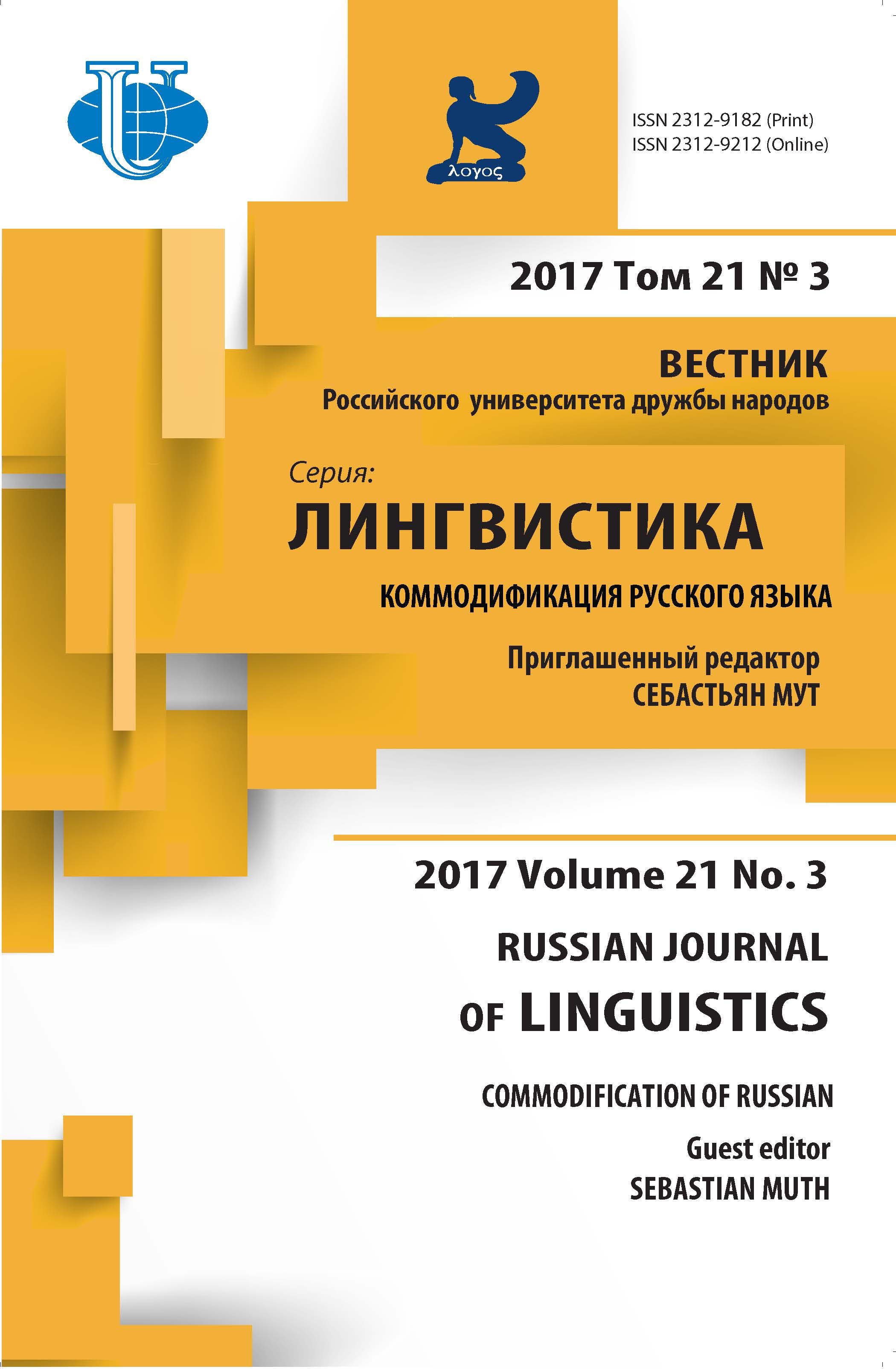LINGUISTIC LANDSCAPE AND WHAT IT TELLS US ABOUT THE INTEGRATION OF THE RUSSIAN LANGUAGE INTO ISRAELI ECONOMY
- Authors: Yelenevskaya M.1, Fialkova L.2
-
Affiliations:
- Technion-Israel Institute of Technology
- The University of Haifa
- Issue: Vol 21, No 3 (2017): Commodification of russian
- Pages: 557-586
- Section: Articles
- URL: https://journals.rudn.ru/linguistics/article/view/16791
- DOI: https://doi.org/10.22363/2312-9182-2017-21-3-557-586
- ID: 16791
Cite item
Full Text
Abstract
About the authors
Maria Yelenevskaya
Technion-Israel Institute of Technology
Email: ymaria52@technion.ac.ie
Maria Yelenevskaya, Ph.D., head of Computer-Assisted Language Learning Laboratory in the Department of Humanities and Arts at the Technion-Israel Institute of Technology. Research interests: the use of language in multilingual and multicultural settings, lingua-cultural aspects of computer-mediated communication and investigation of humor. In collaboration with Larisa Fialkova she has written 28 articles and three monographs. Her professional activities include organization of conference panels, editorial work and reviewing for various journals. She is on the editorial board of two linguistic journals and Israel Association for the Study of Language and Society. Technion City, 3200003 Haifa, Israel
Larisa Fialkova
The University of Haifa
Email: lara@research.haifa.ac.il
Larisa Fialkova, Ph.D., Lecturer in the Department of Hebrew and Comparative Literature at the University of Haifa. Research interests: Russian literature, Slavic and contemporary folklore. She teaches various courses, among them: Folklore and Immigration, Folklore in the Era of High-tech, The Image of the Other in Folklore, Russian and Ukrainian folklore in English, Hebrew, Russian and Ukrainian and so on. In collaboration with M. Yelenevskaya she has written 28 essays and 3 joint monographs. Ave. Abakhoushy Mount Carmel, 3498838 Haifa, Israel
References
- Abousnnouga, G., & Machin, D. (2010) War monuments and the changing discourses of war and soldiery. In Jaworski, A., & Thurlow, C. (eds.), Semiotic Landscapes: Language, Image, Space. London, New York: Continuum, 219-240.
- Aronin, L., & O. Laoire, M. (2013) The material culture of multilingualism: Moving beyond the lin¬guistic landscape. International Journal of Multilingualism, 10(3): 225-235.
- Backhaus, P. (2007) Linguistic Landscape: A Comparative Study of Multilingualism in Tokyo. Clevedon: Multilingual Matters.
- Barni, M., & Bagna, C. (2010) Linguistic Landscape and Language Vitality. In Ben-Rafael, E., Shoha¬my, E., & Barni, M. (eds.) Linguistic Landscape in the City. Clevedon, Buffalo, Toronto: Mul¬tilingual Matters, 3-18.
- Ben Rafael, E., Shohamy, E., Amara M., & Trumper-Hecht, N. (2006) Linguistic Landscape as Symbo¬lic Construction of the Public Space: The Case of Israel. In Gorter, D. (ed.), Linguistic Lands¬cape: A New Approach in Multilingualism. Clevedon, Buffalo, Toronto: Multilingual Matters, 7-30.
- Ben Rafael, E., & Ben Rafael, M. (2010) Diaspora and returning diaspora: French-Hebrew and vice versa. In Shohamy, E., Ben Rafael, E., & Barni, M. (2010) Linguistic Landscape in the City. Bristol, Buffalo, Toronto: Multilingual Matters, 326-343.
- Coupland, N. (2010) Welsh linguistic landscapes “from above” and “from below”. In Jaworski, A., & Thurlow, C. (eds.). Semiotic Landscapes: Language, Image, Space. London, New York: Con-tinuum, 77-101.
- Deutch, Y. (2005). Language law in Israel. Language Policy, 4: 261-285.
- Elias, N., & Greenspan, L. (2007). The honey, the bear and the violin: Russian voices in Israeli advert¬ising. Journal of Advertising Research, 47(1): 113-122.
- Fialkova, L. (1999) Russkii yazyk v Izrail’skoi torgovle. Yazyk emigrantov v svete sotsiolingvistiki (The Russian Language in Israel’s retailing, in Russian), Russistika segodnya, 1-2: 80-89.
- Fialkova, L. (2007) Koly Hory Shkodiat’sia: Narysy z Ukrain’sko-izrail’skykh Fol’klornykh Vzemyn (When Mountains Meet: Essays in Ukrainian-Israeli Folklore, in Ukrainian.) Kyiv: Institute of Art Studies, Folklore and Ethnology, Ukrainian Academy of Sciences.
- Fialkova, L., & Yelenevskaya, M. (2011) Immigrants in the City: From Exploration to Domestication, Israel Affairs, 17 (1): 143-164.
- Fialkova, L., & Yelenevskaya, M. (2013) In Search of the Self: Immigrants’: Reconciling the Past and the Present in Immigrants’ Experience. Tartu: ELM Scholarly Press.
- Fialkova, L., & Yelenevskaya, M. (2013a) Liubimyi prazdnik: Novyi god v emigrantskoi srede v Izraile (Our Favorite Holiday: New Year Celebrations among Immigrants to Israel, in Russian). In L. Fedorova (ed.), Ritual v yazyke i kommunikatsii, Moscow: JSK-RGGU, 255-265.
- Fialkova, L., & Yelenevskaya, M. (2015) The Crisis in Ukraine and the Split of Identity in the Russian-speaking World. Folklorica, XIX: 101-132.
- Glinert, L.H. (1995) Inside the language planner’s head: Tactical responses to a mass immigration. Journal of Multilingual and Multicultural Development, 16(5): 351-371.
- Golan-Cook, P., & Olshtain, E. (2011) A model of identity and language orientation: The case of im¬migrant students from the former Soviet Union in Israel. Journal of Multilingual and Multicul¬tural Development, 32(4): 361-376.
- Gorter, D. (2006) Introduction: The Study of linguistic landscape as a new approach to multilingualism. In Gorter, D. (ed.), Linguistic Landscape: A New Approach in Multilingualism. Clevedon, Buf¬falo, Toronto: Multilingual Matters, 1-6.
- Jaworski, A., & Thurlow, C. (2010) Introducing Semiotic Landscapes. In Jaworski, A., & Thurlow, C. (eds.), Semiotic Landscapes: Language, Image, Space. London, New York: Continuum, 1-40.
- Kelly-Holmes, H. (2005) Advertising as Multilingual Communication. New York: Palgrave Macmillan.
- Kheimets, N., & Epstein, A. (2001) English as a central component of success in the professional and social integration of scientists from the former Soviet Union in Israel. Language and Society, 30(2): 121-143.
- Khvorostianova, N., & Elias, N. (2008) Staryi dom na novoi ulitse? Kul’turnye instituty “russkoi ob¬schiny Ber-Shevy (An old home in a new street? Cultural institutions of the “Russian” Commu-nity in Beer-Sheva, in Russian.) In Nosenko, E. (ed.) Israil’ glazami “russkikh”: Kul’tura i iden¬tichnost’. Moscow: Natalis, 304-328.
- Kliuchnikova, P. (2015) Language attitudes and “folk linguistics” of Russian-speaking migrants in the UK. Russian Journal of Communication, 7(2): 179-192.
- Kopeliovich, Sh. (2013) “Happylingual”: A family project for enhancing and balancing multilingual development. In Schwartz, M., & Verschik, A. (eds.), Successful Family Language Policy: Parents, Children and Educators in Interaction. Dordrecht, Heidelberg, New York, London: Springer, 249-276.
- Landry, R., & Bourhis, R.Y. (1997) Linguistic landscape and ethnolinguistic vitality: An empirical study. Journal of Language and Social Psychology 16, 23-49.
- Lewis, M. P., Simons, G. F., Fenning, C. D. (eds.) (2016) Ethnologue: Languages of the World, 19th edition. Dallas, Texas: SIL International. Online version: http://www.ethnologue.com, last accessed 15 Sept. 2016.
- Marten, H. F., Mensel, L.Van, & Gorterm D. (2012) Studying minority languages in the linguistic landscape. In Gorter, D., Marten, H. F., & Mensel, L. van (eds.), Minority Languages in the Lin¬guistic Landscape. New York: Palgrave Macmillan, 1-18. Buffalo, Toronto: Multilingual Matters, 182-198.
- Mustajoki, A., & Protassova, E. (2014) Russkii sredi drugikh yazykov Finliandii: Aktual’nye problemi (Russian among other languages of Finland: Current Problems, in Russian) In Gasparov, B.M., & Kupina, N.A. (eds.), Russkii yazyk mnogorechnom sotsiokul’turnom prostranstve. Ekaterin¬burg: Ural University Press, 220-239.
- Nelde, P. (1987) Language contact means language conflict. Journal of Multilingual and Multicultural Development, 8(1-2): 33-42.
- Pavlenko, A. (2010) Linguistic landscape of Kyiv, Ukraine: A diachronic study. In Ben-Rafael, E., Shohamy, E., & Barni, M. (eds.) Linguistic Landscape in the City. Clevedon, Buffalo, Toronto: Multilingual Matters, 133-152.
- Pennycook, A. (2010) Graffscapes and city souls. In Jaworski, A., & Thurlow, C. (eds.), Semiotic Landscapes: Language, Image, Space. London, New York: Continuum, pp. 137-150.
- Perotto, M., & Niznik, M. - Перотто, М. и Низник, М. (2014) Po-russki govorim my s detstva. Iz opyta neformal’nogo obuchenia russkomu yazyku v Izraile i Italii. (We have been speaking Russian since childhood: On the experience of informal teaching of the Russian language in Israel and Italy, in Russian.) In Nikunlassi, A., & Protassova, E. (eds.) Slavica Helsingiensia, 5. Instrumentarium of Linguistics. Helsinki, 75-95.
- Remchukova, Е. (2015) Aktual’nye napravlenia sovremennoi rusistiki: sfera gorodskoi nominatsii kak ob’ekta lingvisticheskogo kreativa (Current trends in Russian studies: Name giving in in the city as an area of linguistic creativity, in Russian.) Russkii yazyk i literatura v prostranstve miro¬voi kul’tury. Proceedings of the 13th Congress of the International association of the teachers of Russian Language and literature, 8: 253-258.
- Remennick, L. (2008) «Russkie» izrail’tiane glazami sotsiologa: kul’tura i obraz zhizni (Cultural affiliation and lifestyles of Russian-speaking Israelis: A sociological view, in Russian.) In Nosen¬ko, E. (ed.), Israel through “Russian Eyes”: Identities and Cultures. Moscow: Natalis, 167-185.
- Schwartz, M., & Verschik, A. (2013) Achieving success in family language policy: Parents, children and educators in interaction. In Schwartz, M., & Verschik, A. (eds.), Successful Family Language Policy: Parents, Children and Educators in Interaction. Dordrecht, Heidelberg, New York, Lon¬don: Springer, 1-22.
- Shifman, L., Katz, E. (2005) “Just call me Adonai”: A case study of ethnic humor and immigrant assimilation. American Sociological Review, 70 (5), 843-859.
- Spolsky, Bernard (2001) Language in Israel: Policy, practice and ideology. In Alatis, J. E., & Tan, A.H. (eds.), Language in Our Time: Bilingual Education and Official English, Ebonics and Standard English, Immigration and the Unz Initiative. Washington D.C. George Town University Press, 164-174.
- Spolsky, B. (2009) Prolegomena to a sociolinguistic theory of public signage. In Shohamy, E., & Gor¬ter, D. (eds.), Linguistic Landscape: Expanding the Scenery. London: Routledge, pp. 25-38.
- Spolsky, B., & Cooper, R. (1991) Languages of Jerusalem. Oxford: Clarendon Press.
- Tolts, M. (2011) Demography of the contemporary Russian-speaking Jewish diaspora. Paper presented at the conference Contemporary Russian-speaking Jewish Diaspora, Harvard University, https://www.researchgate.net/publication/233985633_Demography_of_the_Contemporary_Russian-Speaking_Jewish_Diaspora, last accessed 27 May, 2017.
- Woldemariam, H., & Lanza, E. (2015) Imagined community: The linguistic landscape in a diaspora. Linguistic Landscape, 1 (1-2): 172-190.
- Yelenevskaya, M. (2015) An immigrant language in a multilingual state: Status and competition. Russian Journal of Communication, 7(2), pp. 193-207.
- Yelenevskaya, M., & Fialkova, L. (2005) Russkaia ulitsa v evreiskoi strane. Issledovanie fol’klora emigrantov 1990-kh v Izraile, v 2-kh tomakh (Russian street in the Jewish state. Research into the folklore of the emigrants of the 1990s in Israel, in Russian), 2 volumes. Moscow: Russian Academy of Sciences.
- Yelenevskaya, M. and Fialkova, L. (2006) Between dream cities and reality: Personal narratives of Ex-Soviets in Israel. Applied Research for the Quality of Life, No. 1, 189-209.
- Yelenevskaya, M., & Fialkova, L. (2012) “Holiday of Holidays” Festival in Haifa: Between Hope and Reality. Cultural Analysis, 10: 141-156, http://socrates.berkeley.edu/~caforum/volume10/ vol10_events2.html.
- Yuniverg, L. (2015) Russkoe knizhnoe delo v Izraile (Russian book industry in Israel, in Russian). Russkoe literaturnoe echo, http://www.eholit.ru/news/786/, last accessed 10 November 2016.
- Zbenovich, C., & Lerner, J. (2013) Vospitanie - eto rabota: Intercultural Encounters in educational communication within Russian-speaking families on Israel. Russian Journal of Communication, 5(2): 119-140.
- Zukin, S. (1998) Urban lifestyles: Diversity and standardization in spaces of consumption. Urban Studies, 35 (5/6): 825-839.
Supplementary files















